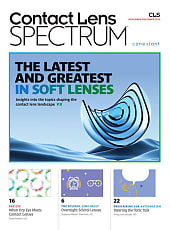Diabetic patients have an increased risk of corneal disorders, including superficial punctate keratitis, recurrent corneal erosions, persistent epithelial defects, corneal ulcers, and a higher likelihood of developing dry eye disease (DED).1,2 These corneal changes comprise the condition diabetic keratopathy (DK). Approximately 46% to 64% of diabetic patients will develop DK.3 As DK can pose a serious threat to a patient’s vision3,4 and it is often misdiagnosed as DED or neurotrophic keratitis,5 diagnosing and managing it effectively is essential.
Diagnosis
Diabetic patients have an increased risk of corneal disorders, including superficial punctate keratitis, recurrent corneal erosions, persistent epithelial defects, corneal ulcers, and a higher likelihood of developing dry eye disease (DED).1,2 These corneal changes comprise the condition diabetic keratopathy (DK). Approximately 46% to 64% of diabetic patients will develop DK.3 As DK can pose a serious threat to a patient’s vision3,4 and it is often misdiagnosed as DED or neurotrophic keratitis,5 diagnosing and managing it effectively is essential.
Unlike DED, DK is caused by a hyperglycemic environment on the cornea.5 The hyperglycemic environment produced by elevated glucose levels increases the levels of Reactive Oxygen Species on the cornea and has a direct effect on the apoptosis of epithelial cells and decreased wound healing. This increased oxidative stress environment also leads to abnormal production of proinflammatory cytokines and chronic inflammation, which affects corneal nerve health.6
The hallmarks of DK are chronic inflammation, decreased corneal sensation and delayed wound healing. Corneal alterations in diabetes manifest through increased corneal thickness, epithelial defects, superficial punctate keratitis, delayed wound healing, and decreased corneal sensitivity. Other items noted clinically:7
• Persistent corneal epithelial erosion
• Delayed epithelial regeneration
• Decreased tear secretion8
• Corneal edema
• Neurotrophic corneal ulcers
• Reduced tear film production9
• Reduction of goblet cell density

Management
The following can manage DK:4
• Increased systemic control of blood glucose levels.
• Preservative-free artificial tears and tear ointments
• Topical antibiotic ointments (to prevent secondary infection from ocular surface disruption)
• Patching (to reduce the friction from blinking on the ocular surface)
• Bandage soft contact lenses (to reduce pain)
• Amniotic membranes (to decrease corneal inflammation and scarring)
• Platelet-rich plasma eye drops (to promote tissue regeneration)
• Autologous serum tears (to promote healing)
• Tarsorrhaphy
• Oral aldose reductase inhibitor (to reduce excess glucose).
Additionally, topical insulin drops are emerging as a new treatment for DK. Specifically, research shows 0.5 units of topical insulin used q.i.d. can effectively heal corneal epithelial defects.10
To increase success with treatment, I have found it’s beneficial to also decrease sources of inflammation from around the eye by treating ocular rosacea, blepharitis and meibomian gland dysfunction with lid hygiene approaches, as an example.
Patients tend to respond poorly to treatments while in the hyperglycemic environment.4 Working together with the patient’s primary care doctor or endocrinologist to improve their blood glucose control is an important step in helping our DK patients to recover.
Serve Diabetic Patients
Knowledge of the distinguishing signs and symptoms of DK, coupled with the latest in management enables the OD to increase the diabetic patient’s visual health. OM
References
1. Zhang X, Zhao L, Deng S, Sun X, Wang N. Dry eye syndrome in patients with diabetes mellitus: prevalence, etiology, and clinical characteristics. J Ophthalmol. 2016;2016:8201053. doi:10.1155/2016/8201053
2. Manaviat MR. Rashidi M, Afkhami-Ardekani M, Shoja MR. Prevalence of dry eye syndrome and diabetic retinopathy in type 2 diabetic patients. BMC Ophthalmol. 2008;8:10. doi:10.1186/1471-2415-8-10
3. Schultz RO, Van Horn DL, Peters MA, Klewin KM, Schutten WH. Diabetic keratopathy. Trans Am Ophthalmol Soc. 1981;79:180-199.
4. Priyadarsini S, Whelchel A, Nicholas S, et al. Diabetic keratopathy: insights and challenges. Surv Ophthalmol. 2020;65(5):513-529. doi: 10.1016/j.survophthal.2020.02.005
5. Buonfiglio F, Wasielica-Poslednik J, Pfeiffer N, Gericke A. Diabetic keratopathy: redox signaling pathways and therapeutic prospects. Antioxidants. 2024;13(1):120. doi: 10.3390/antiox13010120
6. Kim J., Kim C.-S., Sohn E., Jeong I.-H., Kim H., Kim J.S. Involvement of advanced glycation end products, oxidative stress and nuclear factor-kappaB in the development of diabetic keratopathy. Graefe’s Arch. Clin. Exp. Ophthalmol. 2011;249:529–536. doi: 10.1007/s00417-010-1573-9.
6. Ljubimov A.V. Diabetic complications in the cornea. Vis. Res. 2017;139:138–152. doi: 10.1016/j.visres.2017.03.002.
7. Milner MS, Beckman KA, Luchs JI, Allen QB, Awdeh RM, Berdahl J, et al. Dysfunctional tear syndrome: dry eye disease and associated tear film disorders - new strategies for diagnosis and treatment. Curr Opin Ophthalmol. 2017;28(Suppl 1):3-47. doi: 10.1097/01.icu.0000512373.81749.b7.
8. Yeung A, Dwarakanathan S. Diabetic keratopathy. Dis Mon. 2021;67(5):101135. doi: 10.1016/j.disamonth.2021.101135.
9. Fai S, Ahem A, Mustapha M, Mohd Noh UK, Bastion MC. Randomized controlled trial of topical insulin for healing corneal epithelial defects induced during vitreoretinal surgery in diabetics. Asia Pac J Ophthalmol (Phila). 2017t;6(5):418-424. doi:10.22608/APO.201780




